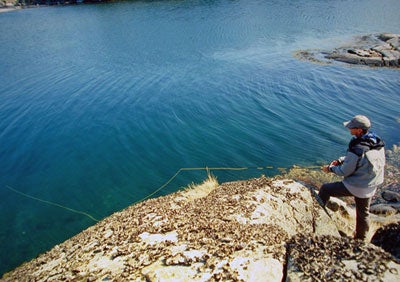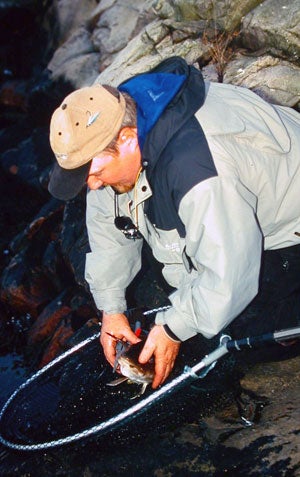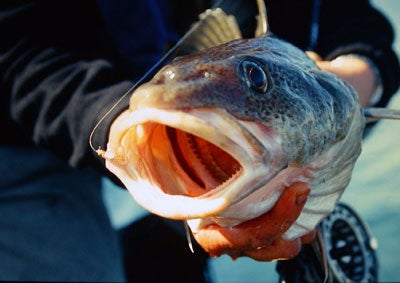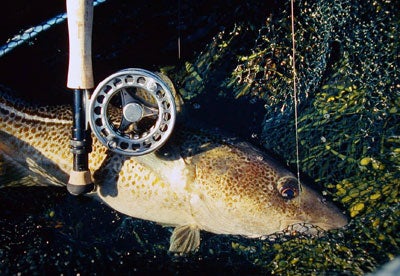| COD NOBBLERS We’d settled down on an idyllic island for a picnic lunch when it happened. Johnny Lunden leapt to his feet pointing and yelling, and along the edge of the shoreline our quarry appeared.
It took me a second or two to spot what he was pointing at, by which time Johnny was racing towards the rods at a speed which belied his usual calm demeanour. But it was something worth seeing. Up from the depths came a large, brown shape which languidly homed in on a patch of bladder wrack just inches from the lapping wavelets. It was, unmistakeably, a large and hungry cod. Within a few seconds, Johnny’s Loop rod was in action, casting a fry imitation at a fish most of us would tackle with a peeler crab on a size 4/0 and 20lb line. The cod was having none of it. When it first surfaced, its penetrating stare gave me the distinct impression it was well aware of our presence. And as Johnny’s frantic casting began, it fanned its fins and turned down again, a shadow heading back into the chasm from which it came. Our first chance was gone. It had already been a long day. The trip to Norway’s southern fjords had started the previous evening when, I confess, the alcoholic attractions of the DFDS ‘Princess of Scandinavia’ had got the better of me. After disjointed slumber in my cabin, I’d then been projected straight into this strange, fantasy world where nothing is quite what it seems.
The home territory of Team Loop Ecofishing Scandinavia is the series of inland lakes that fracture the Norwegian coastline around Kristiansand. And lakes are what they look like. Sometimes reed-fringed, punctuated with forested islands, with little or no evidence of tide, they look for all the world like limestone loughs. They’re not, of course. You may be some miles from the Skagerrak sea, but in front of you is a saltwater lagoon – a chasm left by retreating glaciers into which the seawater floods and provides reservoir fishing conditions for some surprising species. Part of the key to the weirdness of these fjords is their depth. They’re not in the big league of the north-western fjords, but the edges of the islands drop straight into 30 or 40 feet of water, and in many places, you can have 100 feet or more under the hull despite being only a couple of hundred yards offshore. I just couldn’t resist the Loop team’s invitation to sample cod fishing on the fly. It came as we talked over dinner at last year’s Hardy Final at Rutland – the team captained by Peter Eggleton have been forging a place in the British match circuit for five years. It was Peter who introduced me to Johnny Lunden, and in Johnny, I had a master cod fly-rodder and guide.
Cod are among the first target species to arrive after the long, winter waiting game, he explained. The fjords, mainly brackish water, freeze solid during the coldest months putting the rich life within them into suspended animation. Spring comes, though, with a bang and reawakens first the planktonic life, then a spiral of predators until the shore crabs make their way into the seaweed to peel and to breed. And these attract the cod. It had, though, been a longer winter than usual, with deep snow in Oslo in late March, and the fjords had been slow to warm. Johnny had been trying his luck before I arrived, with dismal results despite the spring heatwave Norway had shared with the UK through early April. “Look at the water,” he said as we headed out on to Eidfjord in his team mate Steve Philip’s boat. “It’s so clear you can see the bottom,” and in 25 feet of water, that’s really clear. Once the plankton get going, the clarity goes too. No plankton, no cod… or so the theory said. Fly fishing tactics on the fjords are more or less the same as reservoir tactics; 7 or 8 casting rod, sinking line to match, a 15-foot to 20-foot leader of 6lb or 8lb Sightfree Fluorocarbon, and one or two flies. And even out here, there’s a place for the Blob. When the sea-trout which throng the fjords are out in force, Team Loop are fishing over the front of the boat with a drogue over the side. “The locals have never seen drogues,” said Steven Philip, the Scottish ex-pat and team member. “They think we’ve got a net or something over the side.”
The point fly will generally be something fry-like – a pattern with silver in the body or featuring white marabou, a long ‘wing’ or anything to suggest a fleeing, small fish. They aren’t always big flies. The Team Loop lads have scaled down to size 8s and 10s, with double hooks for point flies when you need to reach the depths. Now and then it pays to match the hatch. And when ragworm are on the rampage, some pretty weird creations come into their own. The ragworm swarm annually, in spring, to breed, and the sea-trout swarm after them. The ‘flies’ are straggling tandem lures made with lengths of green and brown Fritz, or a variety of hand-woven yarns tied to imitate the many-legged worm. Matching the cod’s natural diet of two-inch shore crabs with a fly would be a real achievement. Fortunately, cod will just as happily attack fish fry, so the same flies used for sea-trout will catch cod. Cod may not look too athletic, but according to Johnny, they’ll chase fry imitations at stripping speed. On this, our first day fishing for them, the cod didn’t seem to want to chase anything. Johnny was particularly sullen after spooking the crab-hunting cod in the shallows, and set off on a rock climb for pastures new. Steven picked a rock promontory which had a steep shelf running along its edge. I took in the scenery.
The massive boulders which line the southern fjords are smoothed not by the weather, but by the glaciers which once covered them. Here and there you can see huge score marks an inch deep in the granite where the glaciers slowly ground seawards. In the natural fissures in the rock, pine and silver birches grow, and where the millennia have built up enough leaf litter, delicate flowers bloom. It really is beautiful. My reflections were then disturbed by a whoop from Steven, who’d latched on to a good cod which decided deep water was the safest place to be. There was no controlling the fish – it just stripped 45 metres of line from the spool in one dive. Johnny made his way over with the landing net and, five minutes later, the odd sight of a cod with a tiny gold-head trout fly in its massive mouth was captured on film. “Keith Fraser of Aberdeen tied this one for me,” said Steven with the fly in his hand. “It’s a Glacier Fritz body with white marabou tail and wing, tied on a size 8 grub hook. Thanks Keith!” We’d broken the jinx. The five-pounder was destined for the pot, so after the priest had delivered the last rites, it was gutted to reveal three peeler crabs and the skeleton of one, four-inch fish fry. I couldn’t help thinking a really big Minkie would do the trick for cod, too. We hoped that falling light levels were bringing the cod in, and fished on in anticipation. But the score remained solidly one fish, and we boarded our boat home just before sunset feeling dejected. Our cod expert Johnny looked particularly peeved. When the cod are ‘on’ he said, they show themselves readily and can be stalked as they rummage through the bladder wrack seaweed. Plan B was required.
The next day we trailered the boat to another fjord, Isefjaerfjorden, to escalate our hunt. The longish boat ride out to Bliksfjorden would take us closer to the Skagerrak and, we hoped, closer to cod and sea-trout action. As a sightseeing trip it was phenomenal, the channels through the fjords lined with stunning holiday homes and the massive rock formations breathtaking. But though our number was reinforced with team captain Peter Eggleton, and though we stalked around several islands and bays, the cod and even the sea-trout we could see evaded us. We ended the day at teatime with a few, small consolation pollack and a pretty grumpy Johnny Lunden. I’d been bleating at the boys to take a trip either early morning or evening, when the light is just great for photographs. As this was the last day, we gobbled down dinner at Steven’s house and set out once more for Eidfjord. The sight which greeted us was, to say the least, unusual. The fjord seemed alive with fry, dimpling the surface by the billion. But when we got afloat, it became apparent that the rising ‘fish’ were, in fact, billions of Aurelia jellyfish – a solid blanket of the two-inch creatures gently bobbing in the surface film. “We won’t even get our DI-7 line down through these,” Johnny suggested, I thought rather pessimistically. Nonetheless, we headed for the island which delivered Steven’s cod, and gave it a go. A small pollack gave itself up to Steven’s rod almost straight away, but I followed Johnny – he had the look of a man determined to catch a cod. And after 30 minutes, just as I’d begun to drift off back to Steven, he got his wish. It was a belter of a fish which hooped the rod and thrashed at the surface for five minutes or so before Steven could net it. At about 5lb it was nowhere near the double-figure cod Johnny has caught when the fishing’s on song. But it was good enough. And then Johnny did something which defined the gulf between bait fishing with a size 4/0 and fly fishing. Johnny put the cod back and took his smile home as a trophy. HOW TO GET THERE There are two sailings a week, on Monday and Friday, from Newcastle. DFDS has an excellent website, www.dfdsseaways.co.uk, from which you can choose and book your crossing. If you don’t want to take your car, you can reach Newcastle by GNER rail service and take the DFDS bus from Newcastle Central Station (£ 3 each way) to the ferry dock. Car hire is from the usual companies, most of which have offices in Kristiansand. I stayed in Vennesla at the Vennesla Hotel (email mail@venneslahotell.no) but other accommodation options are available in Vennesla (+47 38 15 97 97) and in Kristiansand and the Sorlandet region (+47 38 12 13 14, www.sorlandet.com). One problem with driving in Norway is the scenery, which can distract you from the road ahead! There are speed traps everywhere, and the alcohol limit for driving is so low you can forget driving within 12 hours of ANY drinking. Not that drinking is a big attraction, with beer at around £ 4.50 a pint or more. Norway is, despite the strong pound, very expensive. A three-course meal at a modest restaurant could cost upwards of £ 40 a head without wine. If you opt for the self-catering option, you’re spoiled for choice. There are plenty of superb campsites, with rentable log cabins, in the area and the supermarkets aren’t overly expensive. Peter Eggleton is planning a series of guided group visits for UK anglers with sea-trout, brown trout, and salmon fishing on the ‘menu.’ Contact Peter with your details by email at pjdj26@hotmail.com and he will add you to his list of interested parties. |
Welcome!Log into your account


















